Fifty Trades of Grey
John Mauldin
March 1, 2013
I get so much broker research that I must admit I don’t usually read it or do so really fast. But the headline above caught my eye, and the piece turned out to be such a fun read, as well as truly thought-provoking and insightful, that I’ve made it today’s Outside the Box. The personalization of a “relationship” with the Fed gives us a decidedly delicious way to think about QE!

Michael Cembalest walks us through the changes in his attitude toward the Fed, from the heady days of early 2009, when
The Fed Chairman’s picture in the paper reminded me of a cross between Sean Connery and King Hussein of Jordan. His message was clear: he was going to shroud the markets in a warm embrace of unbounded, limitless liquidity. It was slow at first, but then appeared everywhere I looked, like an endless, pounding summer rain.
By late summer, though, his impressions shifted:
… as the leaves turned, these opportunities began to fade as capital came back to credit markets. I held on tight, pulled in a convulsion of rising optimism and the search for yield.
But that’s ancient history now, he says:
For the last fifty months, the Fed has been buying Treasuries and Agencies, $2.5 trillion in all … My relationship with the Fed started to change: with its relentless debt purchases and 0% policy rates, the Fed apparently sees me as a rentier capitalist whose savings should be expropriated by keeping short term interest rates below inflation. What’s a rentier capitalist? According to Lenin, someone who ‘clips coupons, who takes no part in any enterprise whatever, whose profession is idleness’. I began to question my feelings about Quantitative Easing, even though it led to a very powerful rally in the credit markets…
He goes on to take a thoughtful look at the pros and cons of QE, with some of the best analysis I’ve seen, concluding with these deathless lines:
A period of diminishing credit returns is upon us, and it’s probably time for those with more than a normal credit allocation to begin saying goodbye. It will not be easy; love knows not its own depth until the hour of separation.
Once credit markets began to tighten, he notes, “investors rushed headstrong into an intense love affair with dividend-paying stocks.” That has certainly been a strong theme here at Mauldin Economics, in both our Yield Shark and Bull’s Eye Investor letters.
I’ll just tease you with the opening lines of his final sections:
What of equity market valuations overall? Has a dreaded Fed-driven overvaluation cycle already begun?…
Reasonable valuations and a modest recovery in the US, China and parts of the developing world should keep the party going….
Nevertheless, the end of the affair will come one day, and probably when I am not expecting it….
I remember the last time I was in this kind of tangled, complicated relationship….
Good stuff and well-written! I will pay more attention to Michael Cembalest in the future, to see if he can keep this up.
This has been a whirlwind week. I finished up in Palm Springs, flew back on Monday, and wrote this week’s TFTF that night. The next day saw multiple afternoon meetings and dinner with Dick Pfister, one of my long-term partners from Altegris. The next morning Jon Sundt, president and founder of Altegris, joined us and we drove out to spend the day with Kyle Bass at his Barefoot Ranch in Athens, Texas, where between meetings and calls we did take a little time for some fun. My son seems to have a knack for skeet shooting, while keeping myself seated on a very gentle horse was more my speed. I needed to see if I could still ride without getting back issues, because I’m supposed to do some trail riding in the Argentinean Andes in a few weeks. I think I am good to go. And we did finalize some plans for helping you navigate the current rather uncertain market landscape. I will let you know as they develop.
Back at home, we are busy making plans to move and put everything into storage while we wait for the new condos to close. I leave for Cafayate, Argentina, next Thursday and will move into a hotel when I return in two weeks, until the new place is finalized. I’ll move in and then move right back out again when construction starts. So, homeless off and on for the next few months, but the end result will be something of a dream come true for me.
The haunting sounds of Ladysmith Black Mombazo’s poignant song “Homeless” keep running through my mind. If you are not familiar with their work, you should be.
Your moonlight sleeping on a midnight lake analyst,
John Mauldin, Editor
Outside the Box
subscribers@mauldineconomics.com
Fifty Trades of Grey
An illustrated story of investment, temptation, addiction, and the cost of money
By Michael Cembalest, J.P. Morgan Asset Management
Q1 US retail sales were better than expected in January, despite higher tax rates, as the US consumer is still more active than European counterparts (1st chart). It’s too soon to see the full impact of higher US income and payroll tax rates, but a Q4 jump in real wages, improved household balance sheets and a turnaround in housing may offset part of the headwind. We’ll see in a couple of quarters. Meanwhile, in the SOTU address, the President talked about raising revenues. It will be interesting to see where they come from: after the recent tax act, top quintile tax rates are now 5 times higher than the second quintile, up from 2x in 1979 as progressivity increases further (2nd chart). Everywhere I go, however, there’s a different topic on everyone’s minds: what will happen when the Federal Reserve stops purchasing tens of billions in Treasury and Agency debt every month? It’s possible that with a sufficiently dovish Chairperson replacing Bernanke in 2014 that they will never end, and that the US will end up like Ireland, with its Treasury perpetually beholden to its Central Bank; but I don’t think so. The autobiographical story below is my view on Fed purchases and their impact on the world of investing.
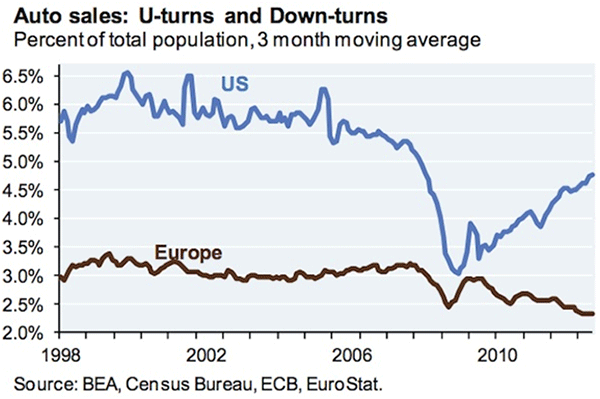
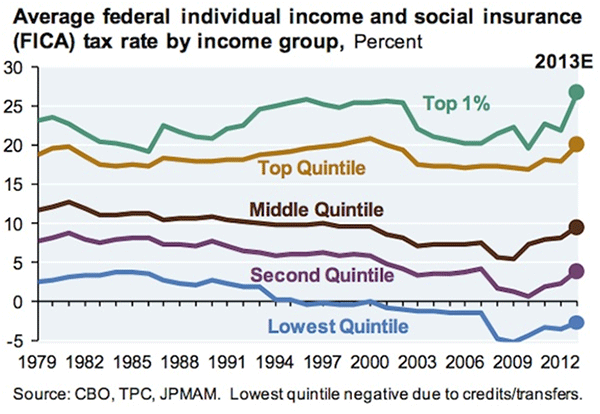
Fifty Trades of Grey
I was always the cautious type. I would wait until other people jumped into a lake to make sure it was deep enough. I have never been on a motorcycle, and have never held or fired a weapon. I once rented a Maserati for a day to see what it was like, and drove under the speed limit the entire time. So, it’s not surprising that by the fall of 2007, with mounting problems in housing, over-crowding in hedge fund strategies like statistical arbitrage and very low credit spreads, I got nervous and reduced portfolio risk heading into 2008. The following fall, after the collapse, I imagined a slow and steady approach to reinvesting. It would take time to rebuild confidence after the second 40% equity market decline in a single decade, right? After recessions in 1989 and 1999, you could take your time reinvesting in credit: high yield spreads remained elevated for 3 to 4 years, allowing for a long, relaxed period of risk-taking by investors with the wherewithal to have avoided some of it in the first place.
Then one day in early 2009, everything changed. The Fed Chairman’s picture in the paper reminded me of a cross between Sean Connery and King Hussein of Jordan. His message was clear: he was going to shroud the markets in a warm embrace of unbounded, limitless liquidity. It was slow at first, but then appeared everywhere I looked, like an endless, pounding summer rain. The convertible bonds we bought in November 2008, and the commercial real estate-backed securities and leveraged loans we bought the following spring, rose in a passionate revival of credit markets. During the first few months of 2009, you could earn 10% or more on debtor-in-possession financing, and purchase private equity interests from overextended college endowments at steep discounts. But by the late summer, as the leaves turned, these opportunities began to fade as capital came back to credit markets. I held on tight, pulled in a convulsion of rising optimism and the search for yield.
That’s ancient history now. For the last fifty months, the Fed has been buying Treasuries and Agencies, $2.5 trillion in all (measured in 10-year equivalents). As the Fed ravishes the riskless debt markets, its demand now accounts for ~55% of the entire net supply issued by the Treasury, Ginnie Mae, Fannie Mae and Freddie Mac. My relationship with the Fed started to change: with its relentless debt purchases and 0% policy rates, the Fed apparently sees me as a rentier capitalist whose savings should be expropriated by keeping short term interest rates below inflation. What’s a rentier capitalist? According to Lenin, someone who ‘clips coupons, who takes no part in any enterprise whatever, whose profession is idleness’. I began to question my feelings about Quantitative Easing, even though it led to a very powerful rally in the credit markets…
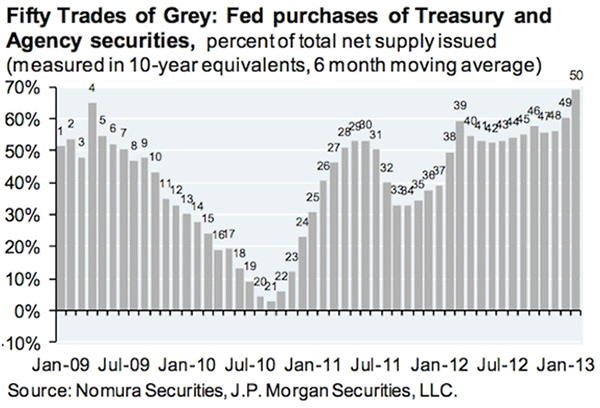
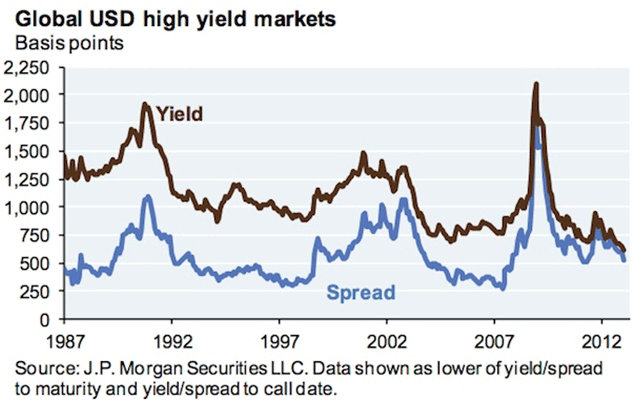
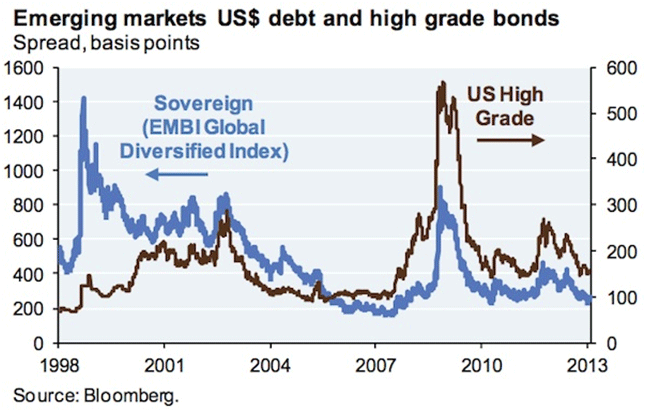
On the plus side for credit, companies have a lot of cash and cash flow and I do not see a recession brewing, so a messy break- up between investors and credit markets seems unlikely this year based on fundamentals. Net of Fed purchases, there will be almost no net debt new issuance in 2013, a very bullish supply picture. (Debt universe: high yield and high grade bonds, EM sovereign and corporate debt, municipals, Agencies, Treasuries and structured credit.) Furthermore, high yield companies have termed out their debt substantially relative to where they stood in 2008, and there has been a revival in CLO and CMBS issuance as structured credit markets improve. Remember as well that the Fed may not raise rates above 1% until 2015 (extrapolated based on the pace of employment gains, labor force participation and the Fed’s reported 6.5% unemployment threshold). For some investors, every bit of coupon income counts: they will be loath to sell, and feel bound to hold their credit positions forever.
However, I’m also watching underwriting standards as investors weaken their emotional resolve. HY issues rated B- or below are rising as a % of issuance. So are debt-to-cash flow multiples on leveraged buyouts, and in Q4 2012, payment-in-kind and covenant-lite issuance hit 2007 levels. This month, Federal Reserve Governor Jeremy Stein voiced concerns about over-heating credit markets, noting ‘reach for yield’ behavior and deterioration in terms and conditions. While high yield spreads don’t look tight in an historical context, yields tell a different story. Given manipulation of riskless rates, I am inclined towards caution. (If you research estimates of the Fed’s impact on long-term interest rates, you might be surprised at how low they are. The latest paper on the subject puts the impact at 35-45 basis points, and other studies show even lower estimates. See “The Federal Reserve’s Large-Scale Asset Purchase Programs: Rationale and Effects”, D’Amico, Nelson, Lopez-Salido and English, December 2012.)
‘Long credit’ is a crowded position, and dealer inventory/liquidity has declined given industry rule-changes (according to Citi, high grade and high yield dealer inventories are 20% of 2007 levels). A period of diminishing credit returns is upon us, and it’s probably time for those with more than a normal credit allocation to begin saying goodbye. (The same view does not hold for credit hedge funds with minimal directional exposure to spreads or rates, and who seek to take advantage of the decline in dealer inventory/market-making and resulting arbitrage opportunities that arise between bonds and credit default swaps.)
It will not be easy; love knows not its own depth until the hour of separation.
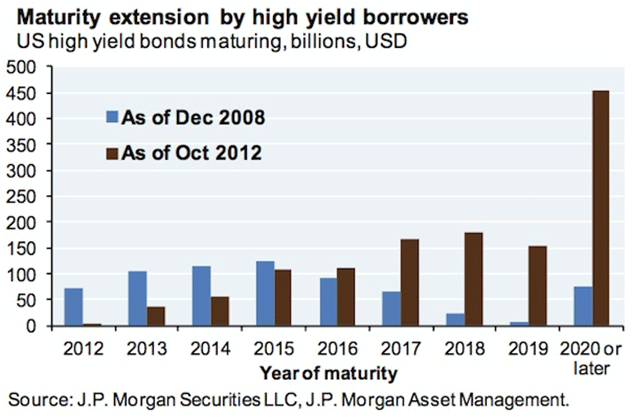
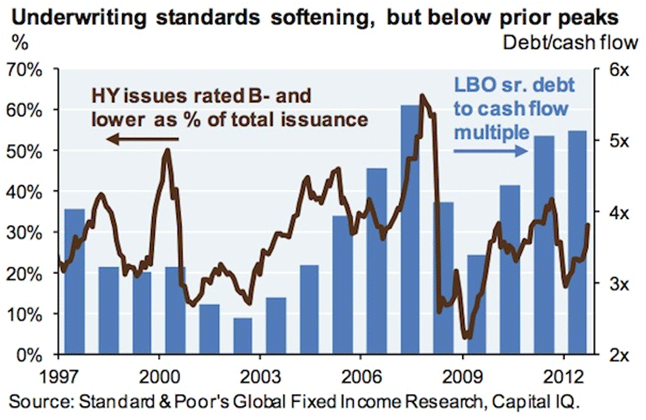
Once credit markets began to tighten, investors rushed headstrong into an intense love affair with dividend-paying stocks. The S&P Dividend Aristocrats Index has outperformed the market by a huge margin starting in 2009, so much so that a few months ago, cyclical stocks were trading at the largest discount on record relative to defensive ones, and still appear to be doing so.
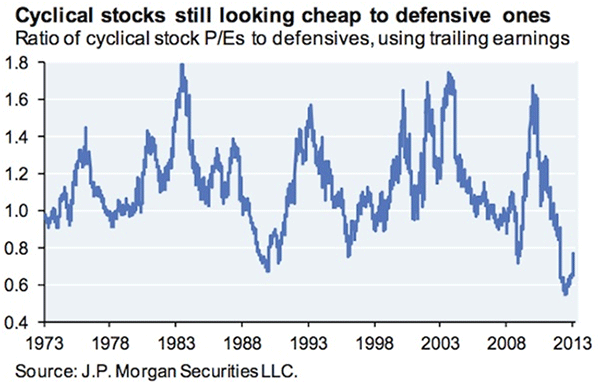
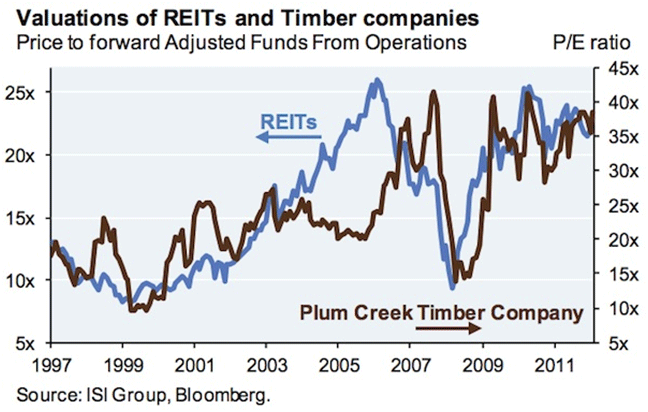
What of equity market valuations overall? Has a dreaded Fed-driven overvaluation cycle already begun? It depends on the lens you apply to remembrance of things past. Using 3 years of trailing earnings, the S&P 500 P/E multiple is around median compared to the last hundred years, and reasonable at a time of low inflation. Using 5 years of earnings makes today’s multiple seem more expensive, since it inherently assumes that the earnings collapse in 2008 will occur every decade (I don’t think this is a good assumption).
Some positives: market expectations of future long-term earnings growth are low, and there’s a lot of corporate and household cash lying around, the most in many decades on a combined basis. What about the equity market-to- replacement cost ratio? It can be a useful buy/sell signal when it’s at extremes, but that’s not the case now. As for other equity valuation methods, such as those which flatter stocks by looking at the fact that I am forced to earn zero percent on my cash, I am trying to cast them aside: the deceptions we tell others are nothing compared to those we tell ourselves.
Reasonable valuations and a modest recovery in the US, China and parts of the developing world should keep the party going. When inflation comes back and the Fed tightens, the party will likely end for a while, but at least right now the output gap (a measure of spare US capacity) still looks large. I have even seen remarks by Bernanke’s courtiers, Evans and Yellen, indicating that the Fed will allow inflation to drift above its long term target for a while to ensure a recovery. In other words, they will postpone the inevitable for as long as they can.
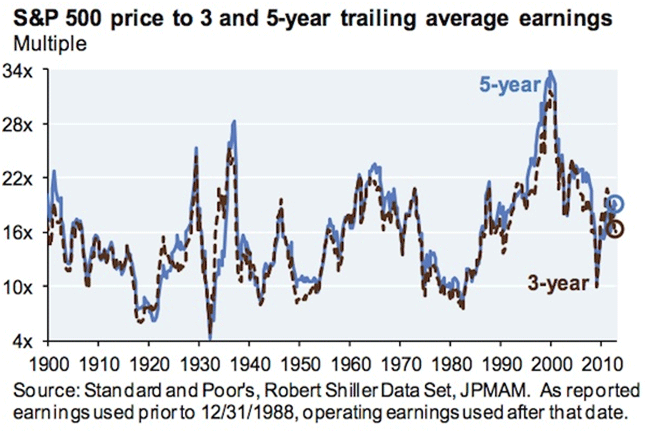
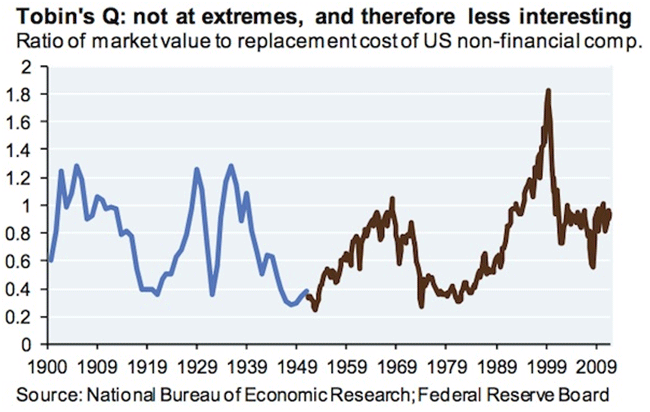
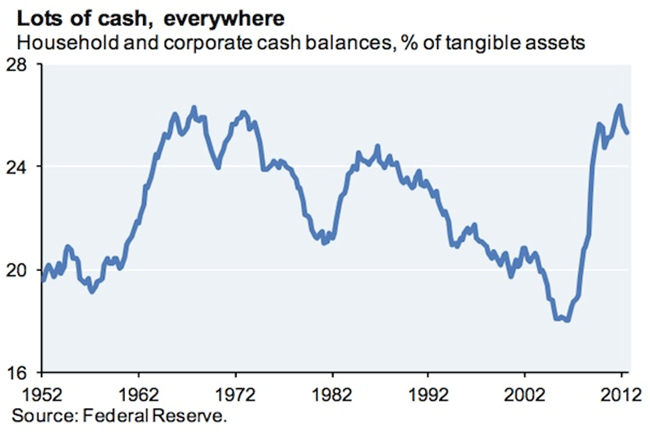
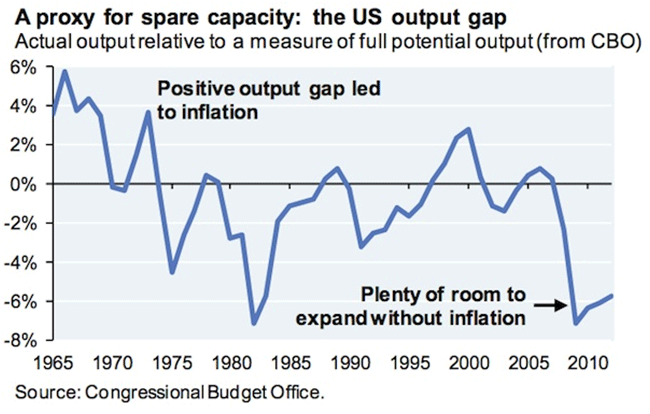
Nevertheless, the end of the affair will come one day, and probably when I am not expecting it. Since the Greenspan- Bernanke era of ultra-low policy rates began, the volatility of equities is even higher than before the creation of the Fed in 1913, when the US was beset by frequent recessions and depressions. So here I remain, trapped in a cycle of market passions that careen from sadness to ecstasy, and then back again. The ecstasy phase has more room to run for now, and we are seeing signs that M&A activity (Berkshire Hathaway and 3G purchase of Heinz, Comcast purchase of GE assets, Liberty Media purchase of Virgin Global) and share repurchases are picking up, which is generally good for stocks. The Fed is looking for ‘substantial’ labor market improvement, which means there will probably be another 12 trades of grey before its purchases end. What kind of imbalances will grow during this time? When the Fed stops buying riskless securities, we will find out how ready risky securities are to stand on their own, and how addicted investors are to Fed support.

I remember the last time I was in this kind of tangled, complicated relationship. It was in 2003: the Fed set policy rates at 1%, below the rate of inflation, and set in motion another cycle in which the value of cash was destroyed. (Inflation was at the same level in 2003 as it was in 1997, yet policy rates were 4.5% higher in 1997. This is a point that Stanford’s John Taylor, a critic of current Fed policy, made last November at the Centennial Celebration of Milton Friedman at the University of Chicago.)
Incredibly, investors in US T-bills earned returns below the rate of inflation until September 2005, which was well into the recovery and around the time the housing collapse began. Fed sponsorship of (another) housing boom and the credit markets was great while it lasted, and I thought the affair would never end. But it did end, with sadness and with betrayal: when it came time for the Federal Reserve to warn me about possible consequences of surging home ownership costs, I didn’t even get an email, or a salacious text. Instead, I read one day in the newspaper that the subprime issue was ‘contained’. Love means never having to say you’re sorry.

